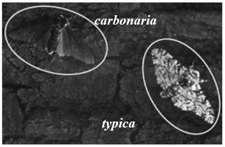In the early part of the 19th century the common form of Biston betularia, called typica, had a peppered appearance. Its wings were flecked with black and white, and it was well camouflaged in its favourite resting place , the pale and lichen covered barks of trees in rural England. A dark or melanistic form of the moth, called, carbonaria, was first recorded in about 1848, and presumably had existed in very small numbers before them, but by the middle of 20th century, the melanistic form of the moth had come to represent over 95% of the Biston betularia population, especially in such industrial centres as Manchester and Liverpool. This is among the most rapid of all recorded evolutionary changes. Why was there such a dramatic change in fortune of the peppered typica and the melanistic carbonaria? With rapid industrialisation, soot came to cover the barks of trees, making them black instead of pale, and also killed the lichens. Now the melanistic form was better camouflaged on the darkened bark, while the peppered form became increasingly less camouflaged and hence more easily detected and eaten by birds. The birds, which had kept the melanistic form at a very low frequency before industrialisation, now concentrated their attention on the peppered-form. Natural selection, in the form of bird predation, favoured the peppered form earlier and the melanistic form later.
- Excert from survival strategies by Raghavendra gadagkar.

Select the option that correctly summarises the given observation in the passage.
- Excert from survival strategies by Raghavendra gadagkar.

Important Questions on Human Evolution
Reason The change in the frequency of a gene that occurs merely by chance and not by selection, in very large population, is called genetic drift
Statement I: The existence of deleterious genes within the populations is called genetic load.
Statement II: The changes in the frequency of a gene that occurs merely by chance in small populations is called genetic drift.
The correct option among the following is
Which of the following refer to correct example(s) of organisms which have evolved due to changes in environment brought about by anthropogenic action?
(a) Darwin’s Finches of Galapagos islands.
(b) Herbicide resistant weeds.
(c) Drug resistant eukaryotes.
(d) Man-created breeds of domesticated animals like dogs.

